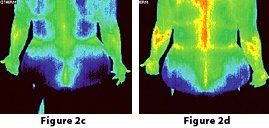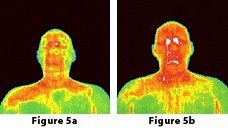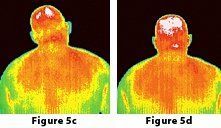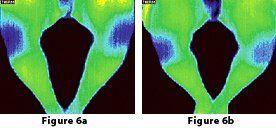Whether you accept it, avoid it or live somewhere in between, insurance coverage has become a defining issue for our profession. Patients increasingly expect to use their benefits, practitioners want to be compensated fairly for their time and expertise, and the system itself remains – at best – fragmented. The encouraging news is that coverage has expanded in meaningful ways. The challenging news is that reimbursement, across the board, remains inadequate.
Warming Up and Cooling Down Simultaneously by External Qi
When we take the oral temperature of a person, if it is much hotter than the normal temperature of 98.6 F°, then we know they are sick. Similarly, when we take infrared images of a patient and find hot spots on the body surface, it generally means some kind of sickness. Healing by external qi generally reduces the temperature at the hot spots. This reduction of temperature at hot spots can be objectively measured quantitatively by taking another set of infrared images after the healing session.
(For readers who are unfamiliar with the details of how healing with external qi is done, please see the documentary "Foundation Project," which can be downloaded free from the Web site www.qluni.org. The mechanism of healing by external qi is explained by quantum theory in my book Biophysics Basis for Acupuncture and Health.)
As I discussed in my last article, sometimes after healing with external qi, the hot spots get even hotter. From many cases I examined, I concluded that the heating up of hot spots generally indicated the sickness was serious.
In rare cases, I actually have observed a very interesting phenomenon: There are simultaneous increases and decreases of body surface temperature in different parts of the body when the person is healed by external qi. Since such cases are rare, I report here three cases of healing with external qi, with quantitative data from infrared images for the readers to ponder its significance:
Case one: One part of the body surface cooled down and three parts of the body surface warmed up.
Case two: Two parts of the body surface cooled down and two parts of the body surface warmed up.
Case three: Three parts of the body surface cooled down and one part of the body surface warmed up.
In all three cases, the healing with external qi was done without the healer touching the patients at all. Let us elaborate these three cases one by one.
Case One
We observed a decrease of temperature on the face of Patient A, as shown in Figure 1, from healing with external qi for 10 minutes. The picture (Figure 1a) was taken before healing started, and another picture (Figure 1b) was taken immediately after healing stopped. The maximum temperature of the face cooled down by 1.19 F°.
We simultaneously observed increases of temperature in three areas of the body: the front, upper back and lower back, below the face. The maximum temperatures of the areas increased by 3.71 F°, 2.39 F° and 1.22 F°, respectively, from healing with external qi. These numbers are obtained from infrared images, as shown in Figure 2. So, we had simultaneous cooling of the face and heating of the rest of the body. The patient had many serious problems with internal organs, which was reflected as an increase of temperature of the front, upper back and lower back from healing.
It was nice to have a control to have a feeling for the reality of this heating up and cooling down of the body surface temperature. Chinese medicine uses personalized diagnostic and personalized treatment. It seemed appropriate to have personalized control. We suggested calling such personalized control self-control. The idea of self-control was to use the patient's own body, which was not affected by the healing process, as a standard to reflect the qualitative and quantitative changes in other parts of the patient's body where health problems existed.
The internal self-control for Patient A was the patient's legs. The patient had no problem with the legs. Figure 3 showed the temperature profile of the patient's legs before and after healing. The maximum temperature of the legs decreased by 0.12 F°, which was negligible. The statistical variation of body surface temperature has been found to range from 0.25 F° to 0.5 F°.
(The color code for infrared images is as follows: White is the hottest, then red, yellow, green and blue, with the coldest temperature being represented in black.)

Figure 1: Temperature profile of the face of Patient A before healing with external qi (Figure 1a) and after healing (Figure 1b). The maximum temperatures of the face before and after healing were 96.04 F° and 94.85 F°, respectively, with a decrease of 1.19 F°.



Figure 2: Temperature profiles of the front, lower back and upper back of Patient A before healing (Figures 2a, 2c, 2e) and after healing (Figures 2b, 2d, 2f). The maximum temperatures of the front, upper back and lower back before healing were 91.36 F°, 90.3 F° and 92.43 F° and became 95.07 F°, 92.67 F° and 93.85 F° after healing, with an increase of maximum temperatures of the front, upper back and lower back by 3.71 F°, 2.39 F° and 1.22 F°, respectively.

Figure 3: Temperature profiles of the legs of Patient A before healing (Figure 3a) and after healing (Figure 3b). The maximum temperatures of the legs before and after healing were 90.89 F° and 90.77 F°, with a temperature decrease of 0.12 F°.
Case Two
In Patient B, we observed decreases of maximum temperatures in the genital area and lower-back by amounts of 1.75 F° and 0.71 F° from healing with external qi for about 10 minutes, as shown in Figure 4.
Simultaneously, we observed increases of maximum temperatures on the face and the upper back area by amounts of 0.71 F° and 0.36 F°, as shown in Figure 5. We used the legs as the self-control, where practically no change of maximum temperatures was observed before and after healing, as shown in Figure 6.


Figure 4: Temperature profile of the genital area and the lower back of Patient B before healing with external qi (Figures 4a, 4c) and after healing (Figures 4b, 4d). The maximum temperatures of the genital area and lower back before and after healing were 94.42 F°, 92.31 F° and 92.67 F°, 91.6 F° respectively, with a decrease of 1.75 F°, 0.71 F°.


Figure 5: Temperature profile of the face and upper back of Patient B before healing with external qi (Figures 5a, 5c) and after healing (Figures 5b, 5d). The maximum temperatures of the face and upper back before and after healing were 92.91 F°, 91.6 F° and 93.62 F°, 91.96 F° respectively, with an increase of 0.71 F°, 0.360 F°.

Figure 6: Temperature profile of the legs of Patient B before healing with external qi (Figure 6a) and after healing (Figure 6b). The maximum temperatures of the legs before and after healing were 88.24 F° and 88.17 F° respectively, with an increase of 0.07 F°. This minute increase was within the normal statistical fluctuation of skin temperature.
Case Three
Patient C received healing from external qi for about 10 minutes. We took infrared images before and after. These images are shown at right (Figures 7-9). The maximum temperatures of three parts of the patient - face, frontal chest area and genital area - decreased by 1.26 F°, 2.18 F° and 2.49 F° respectively.
The maximum temperature of one part of the patient - the lower back - increased 0.43 F° to 1.0 F° from healing. The maximum temperature of the legs of the patient was used as self-control, with no statistically significant change (0.24 F°).



Figure 7: Temperature profiles of the face, frontal chest area and genital area of Patient C before healing with external qi (Figures 7a, 7c, 7e) and after healing (Figures 7b, 7d, 7f). The maximum temperatures of the face, frontal chest area and genital area before and after healing were 94.64 F°, 96.15 F°, 96.58 F° and 93.38 F°, 93.97 F°, 94.09 F° respectively, with a decrease of 1.26 F°, 2.18 F° and 2.49 F°.

Figure 8: Temperature profile of the lower back of Patient C before healing with external qi (Figure 8a) and after healing (Figure 8b). The maximum temperatures of the lower back before and after healing were 94.64 F° and 95.07 F° respectively, with an increase of 0.43 F°. Although the increase of maximum temperature is small, it occurs on a very large area. For the area colored red to become white, it typically involves an increase of 1.0 F° or more. Therefore, we considered the warming of the lower back as a real effect and not a statistical fluctuation.

Figure 9: Temperature profile of the legs of Patient C before healing with external qi (Figure 9a) and after healing (Figure 9b). The maximum temperatures of the legs before and after healing were 90.54 F° and 90.3 F° respectively, with an increase of 0.24 F°. This small increase was considered to be within the normal statistical fluctuation of skin temperature.
Sometimes people ask: Does healing by external qi last permanently or does the sickness return after healing by external qi has stopped? Of course, it is difficult to prove scientifically that the good effect of healing by external qi lasts permanently. We can only show you gradual improvement of Patient C from healing with external qi twice a week. After three weeks, infrared images definitely show improvement from visual comparisons of Figures 7, 8 and 10 for the genital area, frontal chest area and lower back before and after healing with external qi. The maximum temperature of all three parts of the body - the genital area, frontal chest area and lower back - did not increase, but rather decreased by amounts of 2.29 F, 0.97 F and 1.54 F° respectively. So, the seriousness of sickness of the lower back diminishes.



Figure 10: Temperature profile of the genital area, frontal chest area and lower back of Patient C before healing with external qi (Figures 10a, 10c, 10e) and after healing (Figures 10b, 10d, 10f). The maximum temperatures of the genital area, frontal chest area and lower back before and after healing were 94.96 F°, 95.61 F°, 93.38 F° and 92.67 F°, 94.64 F°, 91.84 F° respectively, with a decrease of 2.29 F°, 0.97 F° and 1.54 F°.
Let us conclude by posing an interesting question for readers: Is there a quantitative indication of the gradual improvement of the whole body from comparing several sets of infrared images at different times?
We propose that we might look at the greatest difference among various maximum temperatures of different parts of the body before healing. If this greatest difference is decreasing, then the patient is getting better. If this greatest difference is increasing or stays the same, then the patient is not getting better. For Patient C, the greatest difference of maximum temperatures at the beginning of healing was between the genital area (96.58 F°) and the legs (91.25 F°), which was 5.33 F°. Three weeks later, the greatest difference of maximum temperature before healing became that between the frontal area (95.64 F°) and the legs (92.17 F°), which was 3.47 F°. The greatest difference of maximum temperature decreased from 5.33 F° to 3.47 F°, by an amount of 1.86 F°.
The underlying idea is that for a perfect, idealized person, all body surface temperatures should be the same or have as little difference as possible among different parts of the body. Then the maximum temperatures of different parts of the body would be the same, or as close as possible. In other words, the greatest difference between maximum temperatures of different parts of the body would be very small. The larger this greatest difference is, the further away the person is from normal. As this greatest difference becomes smaller, we may infer the person is getting better.



